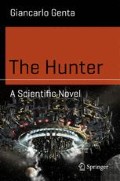Abstract
The action is set in the year 2328, in the system of the double star BD–05 1844 (or Gliese 250) at 28.4 light years (9.2 parsecs) from the Sun. The primary star, BD-05 1844 A is an orange-red dwarf star (K3V), with a mass about 80 % of the mass of the Sun but a luminosity of only 14.6 %. BD-05 1844 B is a red dwarf, (M2.5V), with 50 % the mass of the Sun and only 0.58 % of its luminosity. Their separation is about 500 astronomical units.
Access this chapter
Tax calculation will be finalised at checkout
Purchases are for personal use only
Notes
- 1.
It lies in the east central part (6:52:18.1-5:10:25.4 for Star A and 6:52:18-5:11.4 for Star B, ICRS 2000.0) of the constellation Monoceros.
- 2.
Actually Drexler used the term clanking replicators, to distinguish them from self-replicating machines at the micro- or nano-scale, which he called replicators.
- 3.
The term slow interstellar travel usually indicates interstellar travel at a speed lower than 1 % of the speed of light (v = 0.01 c).
- 4.
The first time replicators were mentioned, by Butler in 1840, they were associated with evolution and were thought to be an application of Darwin’s ideas to machines.
References
G. Dyson, Project Orion, The Atomic Spaceship 1957–1965, (Penguin Books, London, 2002)
J. Dewar, The Nuclear Rocket, (Apogee Books, Burlington, 2009)
M.G. Millis, Breakthrough Propulsion Physics Project: project Management Methods, NASA/TM-2004-213406, (2004), E–14920
M. Alcubierre, “The warp drive: hyper-fast travel within general relativity.” Classical Quant. Grav. 11(5) (1994)
G. Genta, M. Rycroft, Space, The Final Frontier? (Cambridge University Press, Cambridge, 2003)
R.M. Zubrin, D.A. Baker, Mars Direct, A Proposal for the Rapid Exploration and Colonisation of the Red Planet, in Islands in the Sky, (Wiley, New York, 1996)
http://science.nasa.gov/science-news/science-at-nasa/2000/ast07sep_1/
B. Finney, From sea to space, the Macmillan Brown lectures, Massey University, Hawaii Maritime Centre, (1992)
P.D. Ward, D. Brownlee, Rare Earth, (Copernicus, Springer, New York, 2000)
G. Genta, Lonely Minds in the Universe, (Copernicus, Springer, New York, 2007)
R. Penrose, The Emperor’s New Mind: Concerning Computers, Minds and the Laws of Physics, (Oxford University Press, Oxford, 1989)
G. Genta, Introduction to the Mechanics of Space Robots, (Springer, New York, 2012)
R.A. Brooks, Flesh and Machines, (Pantheon Books, New York, 2002)
ABI Report, personal robotics, http://www.Abiresearch.com
I. Yeoman, M. Mars, robots, men and sex tourism, Futures 44(4), 365–371 (2012)
J. Carles, A. Dupleix, Pierre Tehilard de Chardin, (Centurion, Paris, 1993)
K.E. Drexler, Engines of Creation, The Coming Era of Nanotechnology (Oxford University Press, Oxford, 1990)
http://beyondturing.blogspot.it/2012/02/darwin-among-machines.html
F.J. Tipler, The Physics of Immortality (Macmillan, Basingstoke, 1994)
F. Valdes, R.A. Freitas Jr, Comparison of reproducing and nonreproducing starprobe strategies for galactic exploration, JBIS 33 , 402–406 (1980)
R.A. Freitas Jr., R.C. Merkle, Kinematic Self-Replicating Machines, Landes Bioscience, Georgetown, TX (2004)
S. Webb, If the Universe is Teeming with Aliens… Where is Everybody? (Copernicus, Springer, New York, 2002)
C. Sagan, W. Newman, The solipsist approach to extraterrestrial intelligence, Q. J. Roy. Astron. Soc. 24(113), 115 (1983)
Author information
Authors and Affiliations
Corresponding author
Rights and permissions
Copyright information
© 2014 Springer International Publishing Switzerland
About this chapter
Cite this chapter
Genta, G. (2014). Humankind on the Verge of Becoming a Spacefaring Civilization. In: The Hunter. Science and Fiction. Springer, Cham. https://doi.org/10.1007/978-3-319-02060-0_2
Download citation
DOI: https://doi.org/10.1007/978-3-319-02060-0_2
Published:
Publisher Name: Springer, Cham
Print ISBN: 978-3-319-02059-4
Online ISBN: 978-3-319-02060-0
eBook Packages: Physics and AstronomyPhysics and Astronomy (R0)

